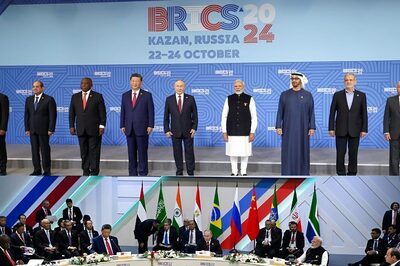
views
- In the US, ISFJ is the most common personality type among the general population (14%) and women (19%). Among men, ISTJ is most common (16%).
- INFJ is the rarest personality type in the US among the general population (1.5%) and men (1%). For women, INTJ is the rarest (less than 1%).
- From most to least common, the personality types are: ISFJ, ESFJ, ISTJ, ISFP, ESTJ, ESFP, ENFP, ISTP, INFP, ESTP, INTP, ENTP, ENFJ, INTJ, ENTJ, INFJ.
What’s the most common personality type?

The most common Myers-Briggs personality type is ISFJ. Also called “the Defender” or “the Protector,” ISFJs make up almost 14% of the general U.S. population. They’re characterized by their empathetic and loyal personalities—ISFJs are often tuned into the feelings of others and dedicate themselves to providing for and protecting their loved ones. They tend to be creatures of habit and prefer a well-organized, structured lifestyle based on established values. ISFJs gravitate to careers that are collaborative, structured, and help others. Popular ISFJ roles include social workers or other mental health professionals, healthcare providers, office managers, teachers, or childcare workers. In relationships, ISFJs are extremely caring, but sometimes reserved. They may have a tendency to self-sacrifice too much and struggle to express their needs. On the Myers-Briggs Type Indicator (MBTI) axes, ISFJs are introverted (I), sensing (S), feeling (F), and judging (J).
What’s the rarest personality type?

The least common Myers-Briggs personality type is INFJ. INFJs are introverted (I), intuitive (N), feeling (F), and judging (J). It may be hard to notice them since they make up less than 2% of the general U.S. population. These types have a strong sense of integrity and crave deep, meaningful connections with others. They appear quiet or gentle and have a knack for sussing out the feelings and motivations of others quite easily. INFJs tend to gravitate toward careers in healthcare, social services, the sciences, education, business, and law. In relationships, INFJs know how to de-escalate conflicts and anticipate their partner’s needs, making them a caring and affectionate partner. The rarest personality types tend to be Intuitives (I) over Sensors (S), as well as Judging (J) more than Perceiving (P). The pros of having a rare personality type include being able to offer diverse and different viewpoints, opinions, and strengths in any situation. The cons of having a rare personality type can include being hard to relate to and having lofty goals that others don’t understand.
Personality Types Ranked
From most to least common, the 16 Myers-Briggs personality types are: ISFJ (13.8%) ESFJ (12.3%) ISTJ (11.6%) ISFP (8.8%) ESTJ (8.7%) ESFP (8.5%) ENFP (8.1%) ISTP (5.4%) INFP (4.4%) ESTP (4.3%) INTP (3.3%) ENTP (3.2%) ENFJ (2.5%) INTJ (2.1%) ENTJ (1.8%) INFJ (1.5%)
Most Common Personality Types by Gender

For women, ISFJ is the most prevalent personality type. About 19% of women in the US are ISFJs, making this personality type more common among women than among the general population or men (only about 8% of men are ISFJs). ISFJ women are highly compassionate and supportive due to their introverted (I) and feeling (F) tendencies and can often be found in careers including nursing, teaching, social work, or counseling. The rarest personality type among women is INTJ.

For men, ISTJ is the most common personality type. ISTJs account for about 12% of the general population (the third most common personality type overall), but 16% of men. ISTJ men are logical, detail-oriented, and value structure and duty. They’re highly practical and traditional, gravitating to careers such as accounting, architecture, surgical or dental work, or logistics management. About 8% of women are also ISTJs, making this type half as common among women than men. ISTJs have much in common with ISFJs. The main difference is that they tend to think (T) objectively and logically when making decisions rather than using their feelings (F) or personal concerns. The rarest personality type among men is INFJ, which is also the least common type among the general population overall.
Traits of Common Personality Types

The most common personality types are Sensors (S) over Intuitives (N). Sensors make up about 74% of all people, while Intuitives account for just 24% of the population. Sensors are factual and process information through their 5 senses, tending to be more realistic, concrete, and practical than Intuitives. On the other hand, Intuitives seek the bigger picture and look to a future of multiple possibilities. They’re more abstract than Sensors and “read between the lines” to gather information. The pros of having a common personality type include relating to others quickly while being easy to understand at the same time. On the flip side, the cons to having a common personality type include being exposed to a less diverse field of ideas and finding it hard to “stand out from the crowd.”
Which personality type is most likable?

ESFJ might be considered the most likable personality type. It’s difficult to label any one type as the “most likable” since every personality has lovable, relatable qualities and unique strengths and weaknesses. However, ESFJs are extroverted (E) social butterflies and people pleasers that tend to get along easily with lots of different types of people. They’re also dependable and protective of their loved ones, making them easy to like! ESFJ is the second most common personality type and has much in common with the most prevalent type, ISFJ.
Myers-Briggs Type Indicator (MBTI) Overview

The MBTI model assesses personalities on four axes, or “preferences.” In this case, a preference is how you orient yourself when focusing your mind or using your brain to make decisions. While you might naturally prefer to do things one way according to your personality type, that doesn’t mean you can’t do things any other way—it just might not be your first instinct. To understand the MBTI personality types, consider these four axes: Extraversion (E) vs. Introversion (I): Extraverts gain energy from interacting with the outer world, people and things, while introverts fuel up by focusing inward on concepts and ideas. Sensing (S) vs. Intuition (N): Those who prefer sensing focus on concrete, tangible details, while those who use intuition look for patterns and future possibilities to construct the “big picture.” Thinking (T) vs. Feeling (F): Thinkers rely on impersonal facts and logic to make decisions, whereas feelers consider personal concerns, relationships, and the people involved. Judging (J) vs. Perceiving (P): Those who judge prefer a structured life and control their world through planning and decision-making (judging), while those who perceive prefer a flexible lifestyle and interact with the world through information gathering (perceiving).




















Comments
0 comment